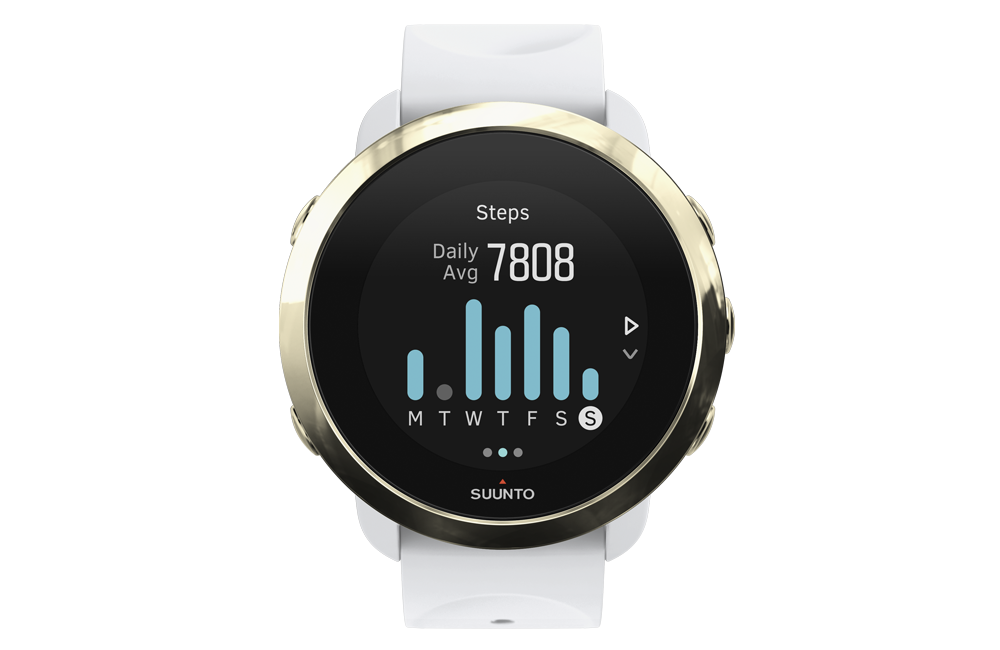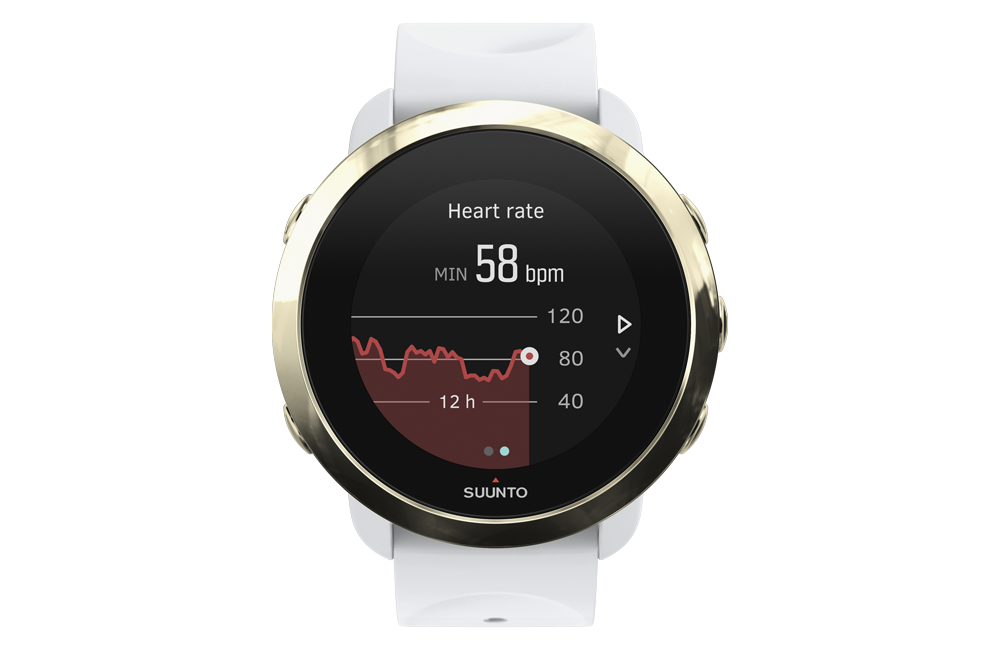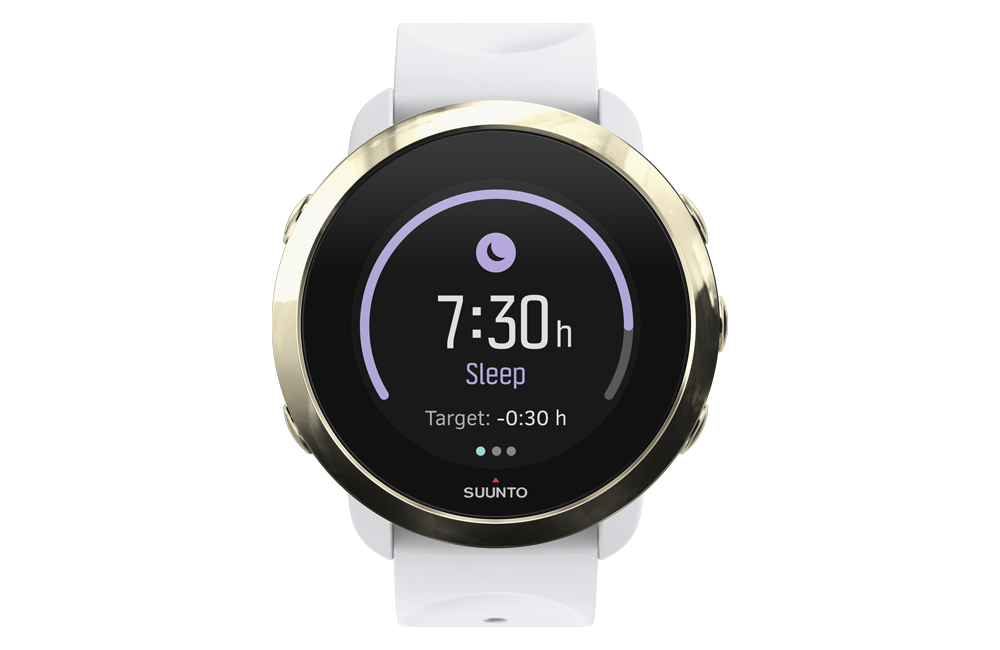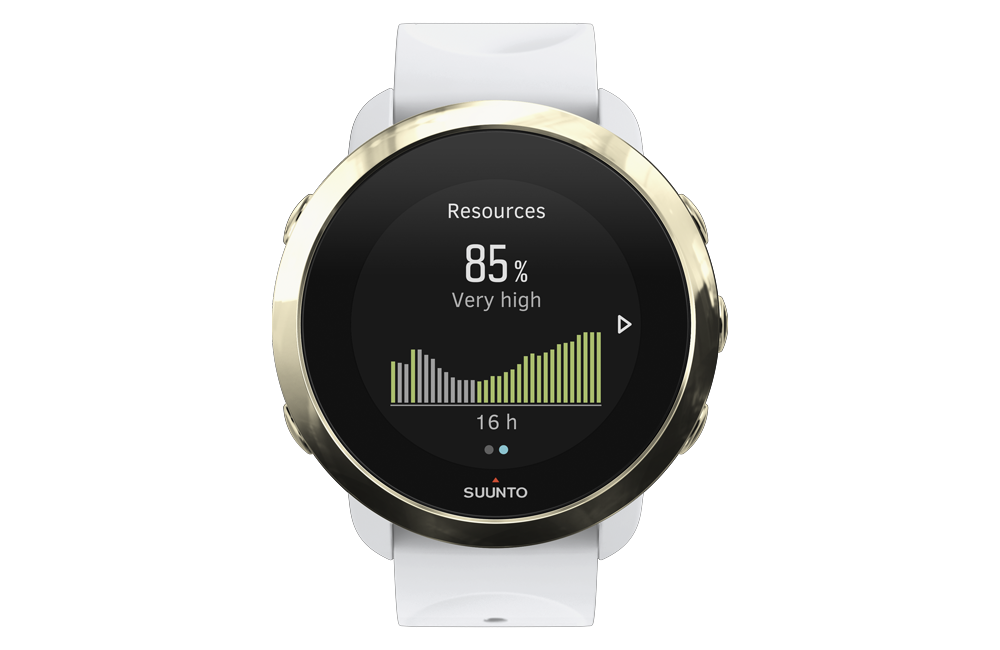TRACK YOUR ACTIVITY LEVELS WITH STEPS AND CALORIES

From the watch face display, press the lower right button until you see your total steps for the day. Pressing the middle button once will reveal your steps over the last seven days.
Your Suunto 3 keeps track of your overall level of activity throughout the day. It counts steps using an accelerometer. The total step count accumulates 24/7, also while recording exercises and other activities. However, with some specific sports, such as swimming and cycling, steps are not counted.
To switch from daily steps to estimated daily calories, press the upper left button. The total calories you burn per day is based on two factors: your Basal Metabolic Rate (BMR) and your physical activity.
Your BMR is the amount of calories your body burns while at rest. These are the calories your body needs to stay warm and perform basic functions like blink your eyes or beat your heart. This number is based on your personal profile, including factors such as age and gender.
When you set a calorie goal (see below), you define how many calories you want to burn in addition to your BMR. These are your so-called active calories.
The large number in the center of the display is the estimated amount of active calories you have burned so far. Below this you see the total calories burned. The total includes both active calories and your BMR.
You can view a weekly summary in your watch or long-term trends in the diary section of your Suunto app.
SET YOUR ACTIVITY GOALS
The ring in both the steps and calories displays indicates how close you are to your daily activity goals. You can adjust the goals in your watch settings (Settings >> Activity) or by keeping the middle button pressed in the activity display to open the activity goal settings.
When setting your target for steps, you define the total number of steps for the day. When you set your calorie goal, you define how many calories you want to burn in addition to your BMR.
Both activity counters automatically reset at midnight every day.
FOLLOW YOUR DAILY HEART RATE TREND

Enable Daily HR under the Activity settings (Settings >> Activity)
The daily HR display provides a 12-hour view of your heart rate. This is a helpful source of information about, for example, your recovery after a hard training session.
The display shows your heart rate over 12 hours as a graph. The graph is plotted using your average heart rate based on 24-minute time slots. In addition, you get your lowest heart rate during the 12-hour period.
Your minimum heart rate from the last 12 hours is a good indicator of your recovery state. If it is higher than normal, you probably are not fully recovered yet from your last exercise.
TRACK YOUR SLEEP DURATION AND QUALITY

Suunto 3 tracks your sleep, too.
A good night's sleep is important for a healthy mind and body. You can use your Suunto 3 to track your sleep and follow how much sleep you are getting and how well you are sleeping.
A lack of sleep or sleep that does not provide sufficient recovery exposes you to illnesses and weakens your physical fitness. Your body can withstand individual nights of sleep that do not provide sufficient recovery, but if the situation drags on, the risk of overload increases.
Turn sleep tracking on and set your bedtime at settings (Settings >> Sleep >> Sleep tracking). The last step defines your bedtime. Your watch uses that period to determine when you are sleeping (during your bedtime) and reporting all sleep as one session. It is better to set the bedtime a little longer than you actually will be sleeping to make sure you get all your sleep tracked. If you get up for a drink of water during the night, for example, your watch still counts any sleep after that as the same session. At the settings you can also set a target duration for your sleep.
Duration is only one aspect of sleep. The amount of sleep we need changes from day to day, from person to person, and even as we get older. We have all woken up after a full 8 hours of sleep feeling tired, particularly during stressful times. At other times, we wake up fresh with a good deal less sleep than expected.
Not all sleep is equal. Quality matters. Personal, behavioral, dietary, and environmental factors can all impact the restorative quality of your sleep. That’s why you can also track your sleep quality with your Suunto 3 Fitness.
Your sleep quality is assessed by following your heart rate variability during sleep. The variability is an indication of how well your sleep is helping you rest and recover. Sleep quality is shown on a scale from 0 to 100 in the sleep summary, with 100 being the best quality.
To measure sleep quality you will need to have Daily HR on (see above). Learn more here.
When you wake up in the morning you will see a summary of your sleep. You can follow your overall sleep trend by scrolling down to the sleep insight from the watch face or in diary of your Suunto app.
LEARN TO MANAGE STRESS AND RECOVERY THROUGHOUT YOUR DAY
Your Suunto 3 also measures your stress and recovery throughout the day to help you ensure you have enough in the tank to make it through the day.
Stress and physical activity deplete your resources, while rest and recovery restore them. Good sleep is an essential part of ensuring your body has the resources it needs.

The gauge around this display indicates your overall resource level. If it is green, it means you are recovering. If it is gray, you are not recovering, but can still be adding to your overall resources. The status and time indicator tell you your current state (active, inactive, recovering or stressed) and for how long you have been in that state.

Press the middle button to see a bar chart of your resources over the last 16 hours.
When your resource levels are high, you will likely feel fresh and energetic. Going for a run when your resources are high means you'll probably have a great run, because your body has the energy it needs to adapt and improve as a result.
Being able to track your resources can help you manage and use them wisely. You can also use your resource levels as a guide to identify stress factors, personally effective recovery boosting strategies, and the impact of good nutrition.
Stress and recovery uses optical heart sensor readings. To get those during the day, daily HR must be enabled (see above).
The sleep quality tracking and stress and recovery monitoring have been developed in close cooperation with Firstbeat Technologies, Suunto’s long-term partner in sports sciences.